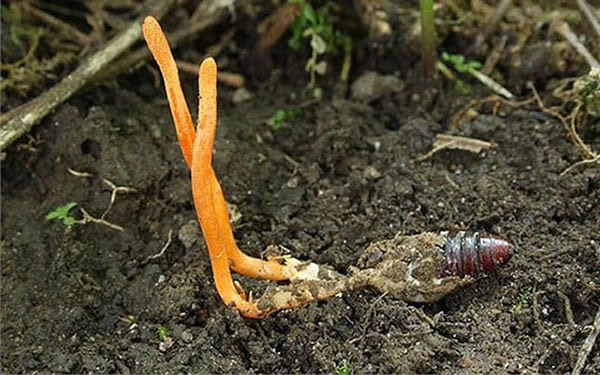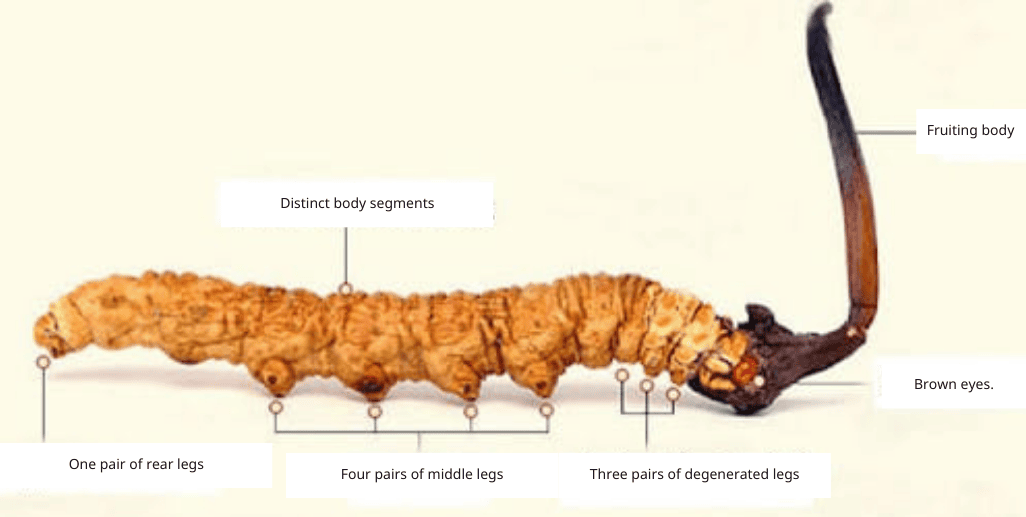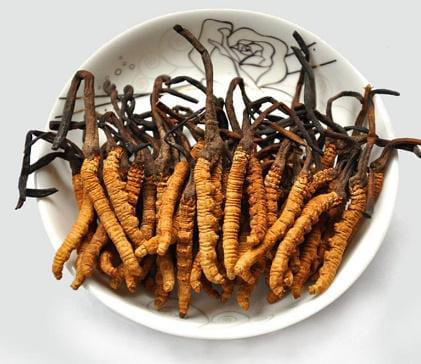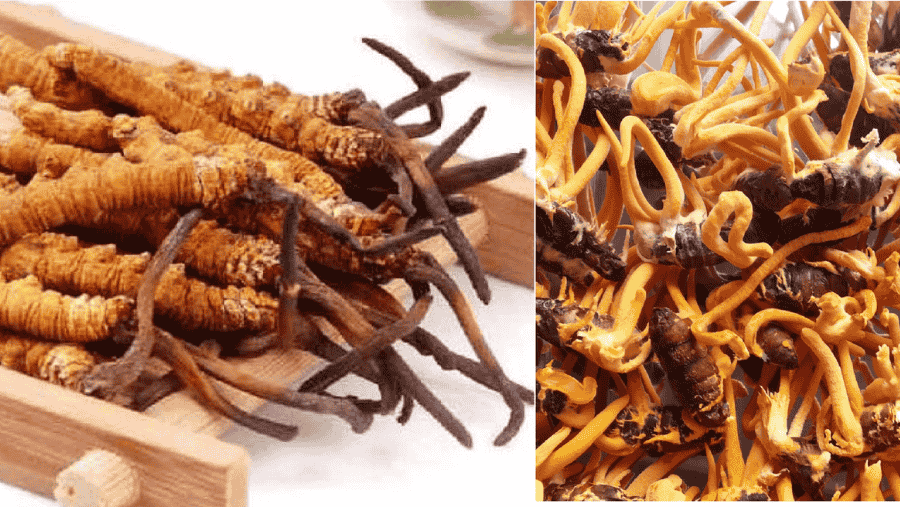Cordyceps Sinensis, also known as “dong chong xia cao” or “summer grass winter worm”, is a medicinal fungus originating from the high plateaus of Yunnan and Tibet in China. It is a premium herbal medicine that has been widely sought after in recent years.
General Information
Names and Scientific Classification
- Vietnamese name: Đông trùng hạ thảo.
- Other names: Summer grass winter worm, Cordyceps.
- Scientific name: Cordyceps sinensis (Berk) Sacc. This is a species of fungus belonging to the family Hypocreaceae.
Natural Characteristics
Cordyceps Sinensis is a natural medicinal fungus that appears small, cylindrical, and slender, measuring 3-6 cm in length, or 10-11 cm when young. It is solid and hollow in the middle. The body is thicker at the bottom and tapers toward the top, with a spindle-shaped, rough texture at the head, featuring tiny dots visible under a microscope as perithecia (reproductive organs).
The fruiting body is oval or slightly round, containing ascospores with short stalks. These spores are divided into individual compartments.
Cordyceps Sinensis was discovered decades ago in the Himalayas of Tibet, at altitudes ranging from 3,500m to over 5,000m, under extreme climatic conditions. Here, it is recognized as a rare parasitic fungus that grows on the larvae of ghost moths.
Winter Behavior: During freezing winter, the larvae host the fungal spores, hibernating underground. These fungal spores penetrate the larvae, consuming its nutrients, and slowly causing its death.
Summer Growth: As the weather warms, the fungus sprouts a brown fruiting body from the larvae’s head, growing above the soil. This phenomenon earned its name, “summer grass, winter worm.”
Normally, the caterpillars would transform into moths after hibernation. However, if infected by the parasitic fungus Cordyceps sinensis, they become Cordyceps.

Distribution, Harvesting, and Processing
Distribution
Natural Cordyceps Sinensis results from the parasitic relationship between fungi of the genus Cordyceps and the larvae of moth species from the genera Hepialus, Brihaspa, or Allomyrina. Wild Cordyceps Sinensis is primarily found on the plateaus of Yunnan and Tibet, China.
Cultivated Cordyceps Sinensis, on the other hand, is produced through human-controlled cultivation on silkworm larvae or on alternative substrates such as green bean mixtures, eggshells, brown rice, and ground silkworm pupae to simulate natural living conditions.
Harvesting and Processing
The ideal time to harvest Cordyceps Sinensis is during the summer, from March to July each year. In the wild, they are found in remote, hard-to-reach areas and are often as small as the stem of an apple. Harvesters typically dig a 10 cm hole around the valuable fungus and carefully remove it from the ground.
For cultivated Cordyceps Sinensis, the fungus is grown in substrate containers under controlled environmental conditions. When ready, the fungi are harvested in sterile conditions and then processed for long-term use:
- Fresh form (whole): Harvested and kept intact for up to one month to preserve its maximum nutritional and bioactive properties.
- Dried form: Fresh Cordyceps is dried to extend its shelf life, making it more convenient to use and transport while retaining its high medicinal value.
- Processed form (functional foods): Many functional food products are derived from this special fungus in various forms, including:
- Liquid.
- Powder.
- Capsules.
Usable Parts
The entire plant body of Cordyceps, including the fruiting body above ground and the remaining larvae, is harvested and utilized.

Chemical Composition
Researchers in China have extracted approximately 1% of a unique acid called cordycepic acid (3-4-5 tetraoxyhexahydrobenzoic acid), structurally similar to quinic acid. Additional compounds and unknown active ingredients have also been identified.
- Cordyceps contains 25-32% protein, which, upon hydrolysis, produces glutamic acid, histidine, proline, valine, arginine, oxyvaline, and alanine.
- The fungus also contains 8.4% fat, with 82.2% unsaturated fatty acids (linoleic acid 31.69%, linolenic acid 68.31%) and 13% saturated fatty acids (as noted by Luu Tho Son and colleagues, 1963).
Medicinal Uses
Traditional Medicine
Cordyceps Sinensis is warm in nature, sweet in taste, and enters the lung and kidney meridians. It helps nourish the lungs and kidneys, stop bleeding, enrich vitality, and dissolve phlegm.
Modern Medicine
- Immune System Boost:
Both natural and cultivated Cordyceps Sinensis significantly enhance the immune response. Studies on mice have shown:
- Increased spleen size.
- Reduced thymus size.
- Prevention of spleen, liver, and thymus atrophy caused by cyclophosphamide.
- Extracts of Cordyceps Sinensis stimulate macrophage production and enhance phagocytic activity, including boosting macrophage alkaline phosphatase levels.
- Reproductive Health:
Clinical trials have demonstrated Cordyceps Sinensis’ effectiveness in treating reproductive dysfunction.
- Blood Sugar Regulation:
Cordyceps reduces blood sugar levels without affecting plasma insulin levels.
- Antioxidant Properties:
Polysaccharides extracted from Cordyceps Sinensis exhibit strong antioxidant activity, protecting cells from free radical damage.
- Liver and Kidney Protection:
Cordyceps protects against aminoglycoside toxicity and cyclosporin A in elderly patients.
- Other Benefits:
Cordyceps increases white blood cell counts in patients with hematopoietic suppression, boosts immunity, and helps balance adrenal gland weight during chemotherapy or radiation therapy.

Dosage and Usage Methods
Fresh Cordyceps:
- Rinse gently in warm water, then soak for an additional 10 minutes for cleanliness.
- Consume directly by chewing slowly to absorb all nutrients.
- Recommended daily dosage: 6-12 g.
Dried Cordyceps:
- Brewing tea: Use 3-7 g of dried Cordyceps and steep in 200 ml of boiling water for 10 minutes. Consume throughout the day.
- Honey infusion: Mix 15 g of Cordyceps with 500 ml of pure honey for 15-20 days. Stir one spoonful into warm water and drink every morning.
- Alcohol infusion: Soak 3-5 g of Cordyceps in 1 liter of 35-45° alcohol for one month. Drink one small cup daily before bedtime.
- Cooking: Add Cordyceps to soups or porridge during the final minutes of cooking.
Precautions When Using Cordyceps Sinensis





